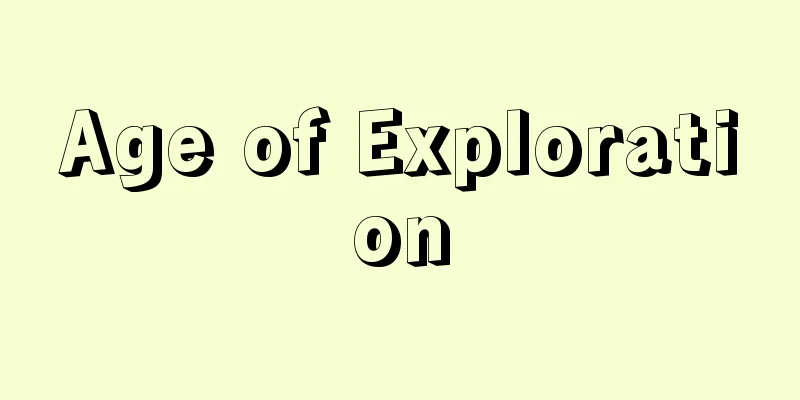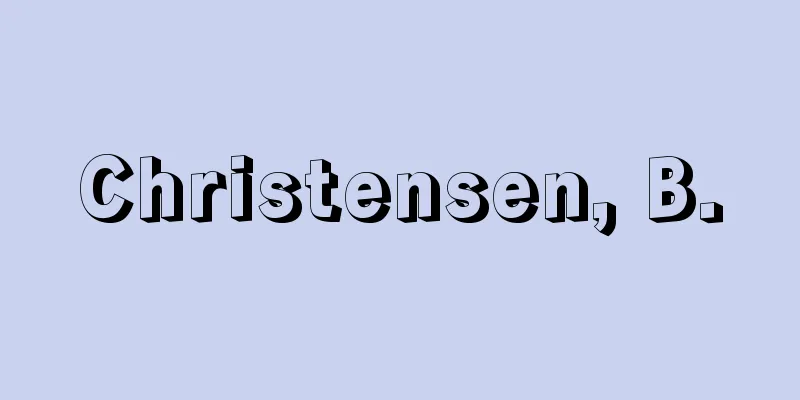Age of Exploration

|
This was the period from the early 15th century to the early 17th century in Western Europe, when two countries on the Iberian Peninsula (Portugal and Spain) led the way in turning their attention from the Mediterranean world to the whole world, mainly through ocean voyages, and confirming one after another that various parts of the world that had previously been the realm of legend and fantasy were in reality through voyages of exploration. Since the content of this period was mainly geographical "discoveries" made by Europeans all over the world, this period is also called the "Age of Geographical Discovery," but it is based on the traditional view of history (European view of history) of "discovery" from a Eurocentric standpoint. Therefore, this also resulted in the subsequent colonization of non-European regions by modern European nations. [Iizuka Ichiro] Historical backgroundAs early as 711, Muslims such as Arabs and Moors invaded the Iberian Peninsula, establishing an Islamic system of rule that lasted for 780 years, making it the only place in Europe where Islamic culture flourished. One of the most notable things about this was that Greek learning translated into Arabic was retranslated into Latin in the Iberian peninsula and spread throughout the Christian world. Among these were the theory of a spherical world, as advocated by the Pythagoreans in the 5th century BC, and the existence of Atlantis, as advocated by Plato and others. Furthermore, there was the theory of a spherical Earth by Saint Isidore of Seville in the 7th century; the first world map using a projection by Eratosthenes, the librarian of Alexandria in the 2nd century BC; the world map in Strabo's Geography from the 1st century BC which predicted the existence of a new continent; and the Geography of Ptolemaios Klaudios (2nd century), which was passed down through Pomponius Mela (1st century). The theory of the existence of an antipodean earth was also known, although it was rejected by Church Fathers Lucius Caecilius Firmianus Lactantius, Gregorios ho Nazianzos, and Augustine. However, the theory was also known from Guillaume de Conches (12th century), Albertus Magnus (13th century), Pietro d'Abano (14th century), and Cecco d'Ascoli of the University of Bologna (1327). Furthermore, Jacobus Angelicus translated Ptolemy's Geography into Latin (1409), Ptolemy's map was printed in Italy (1477), and Pierre d'Ailly wrote Imago Mundi (The Shape of the World) in 1410, which summarized the spherical Earth theory of Greek, Roman, and Arabic scholars. At the same time as these theoretical studies, interest in the descriptions of the Orient in Marco Polo's Travels during the Crusades and the Reconquista, actual voyages of exploration began to be attempted with the goal of contacting the country of Prester John, a Christian country believed to be located deep in Africa, or of obtaining silk, pottery, spices, and other Oriental products that were entering Islamic lands directly without going through Islamic merchants, or of discovering a route to the Orient directly. [Iizuka Ichiro] Portuguese ExplorationIn 1415, three sons (Duarte, Pedro, and Henry) of King John I of Portugal (reigned 1385-1433) and Queen Phillipa (daughter of John of Gaunt, Duke of Lancaster in England) captured Ceuta, an Islamic stronghold in Northwest Africa, across from Gibraltar, as one of the conditions for becoming knights. The third prince, Henry, stayed there afterwards and returned home after gathering information about the west coast and interior of Africa. The nation then promoted voyages of exploration with two goals: one to find the country of Prester John, and another to bring the Islamic trade sphere, which was mainly focused on salt, ivory, gold, and slaves, into Christian hands. They sailed to the Canary Islands, Madeira, and the Azores, rounded Cape Boadour of Eanes in 1434, the Senegal River in 1444, and Cape Verde the following year, and after the death of Prince Henry, they explored the Ivory Coast and the Gold Coast, and in 1482 built a fort in Elmina (present-day Ghana), which would eventually become the center of the slave trade (with Cristóbal Colóm's participation). Diogo Cam (Cão) then discovered Congo and Angola, and continued south along the west coast of Africa. After 1487, Pedro de Covilhão, on the king's orders, traveled overland via Aden to the spice trading areas on the west coast of the Indian peninsula, and then traveled south from Ormus on the Persian Gulf to the Red Sea and the east coast of Africa to the mouth of the Zambezi River. And finally, one of Portugal's greatest achievements was the exploration that took place. Bartolomeu Dias set sail from Lisboa (Lisbon) in 1487, sailed east around the Cape of Good Hope, the southernmost point of Africa, and then sailed slightly north along the east coast before returning home in December 1488. Next, Vasco da Gama set sail from Lisboa on July 8, 1497, sailed around the Cape of Good Hope via the Cape Verde Islands, passed through Malindi on the east coast of Africa, and arrived in Kozhikode (Calicut) on the Malabar coast of India on May 20, 1498. This marked the realization of Portugal's long-cherished wish to discover a sea route to India, and from then on Portugal would send large fleets in this direction. [Iizuka Ichiro] Discovery of AmericaIt is generally believed that Cristóbal Colón (Columbus) was the discoverer of the Americas, but strictly speaking, he was not necessarily the first European to reach the continent. There is also a theory that a group of Normans who reached Greenland from Iceland in the 9th or 10th century had already reached North America, and maps that they left behind at that time have been discovered. There is also a theory that the Portuguese, who later rediscovered the Azores and Canary Islands, reached Greenland and North America in search of the legendary land of Antilla, the "island of seven cities," and the island of Brazil in the Atlantic Ocean. However, these events were not recorded well, and were forgotten afterwards, and did not have any significant significance in world history. In that sense, the voyage of Cristóbal Colón, which has definite evidence that it should be recorded in modern world history, is significant as one of the important events of this period (the Age of Discovery). However, until his death, Colon considered the land he discovered to be part of the Orient (Indies), called the indigenous people there "Indians," and searched for the golden island of Zipangu (Japan) nearby, so he may not have been aware that he had discovered a "new continent." In any case, Portugal, to whom Colon first petitioned for his "plan" to sail west, rejected the plan because they had soon discovered a sea route that would take them down the west coast of Africa and then detouring east to the Orient, so Colon ended up petitioning King Isabella of Spain. However, Spain's voyage of exploration in this direction was delayed by Portugal, as they were preoccupied with the Reconquista, which was reaching its final stages at home, and it was not until April 1492, just after the fall of Granada, that Colon's "plan" was approved. Colon made four voyages. The first one was on the morning of August 3, 1492, when he left Palos in southern Spain with three ships, and after passing through the Canary Islands, he recognized an island in the Bahamas before dawn on October 12, naming it San Salvador. He then confirmed Cuba, Haiti, the Lesser Antilles, and other islands, before returning to the port of Palos in March of the following year. A papal bull from Pope Sixtus IV in 1481 had already recognized the discovered lands on the west coast of Africa, including Guinea, as Portuguese territory, and the Treaty of Alcáçovas in 1479 had previously determined that Spain would not interfere with the lands discovered by the Portuguese and their possession. So, following Colon's advice, Spain immediately applied to Pope Alexander VI for the ownership of the discovered lands. In 1493, the Pope issued four bulls recognizing Spain's sovereignty and deciding that the land area to the west of the Azores and Cape Verde Islands would be Spanish territory, and the area to the east would be Portuguese territory, with a meridian running north-south at sea 100 leagues (about 483 km) west of the Azores and Cape Verde Islands as the border. However, the longitude of the westernmost points of the Azores and Cape Verde Islands differs by six degrees, and the 100 leagues measured west from each was extremely inaccurate, so the border was left to direct negotiation between the two countries. In the end, in the Treaty of Tordesillas on June 7, 1494, the line decided by the Pope was moved another 270 leagues (about 1,304 km) west, and the border was decided to be the north-south meridian at sea 370 leagues (about 1,786 km). As a result, the part of South America that protruded to the east (Brazil) became Portuguese territory. When Colom returned from his first voyage, the "false" news of the discovery of the Indies spread throughout Europe, and a second voyage was immediately planned, setting sail from Cadiz in September 1493, heading slightly south from his previous voyage, exploring the Lesser Antilles, Haiti, and other islands, before returning home in 1496. He then made a third voyage (1498-1500) and a fourth voyage (1502-04), but he was unable to find a route to go further west, and Colom's position gradually worsened. By the time Colon set out on his third voyage (1498), Vasco da Gama had already sailed around the southern tip of Africa and reached India. Amerigo Vespucci, the chief pilot sent by King Manuel of Portugal in response to a report from Pedro Alvares de Cabral, who is said to have discovered Brazil, left Lisboa in May 1501, passed Santa Cruz on the east coast of South America, where Cabral had arrived in May of the previous year, and reached Rio de la Plata. He then sailed south across the Atlantic Ocean to around 46 degrees south latitude, but turned northeast due to rough weather in the Antarctic Circle, and returned to Sierra Leone on the west coast of Africa, returning to Lisboa in September 1502. During this voyage, he became convinced that the area west of the Atlantic Ocean that Colon had reached was not the Indies, but was almost certainly the "fourth continent" after Europe, Asia, and Africa. In a letter he wrote to Lorenzo Piero Francesco de' Medici from Lisboa in April 1503, he described this place as the "New World" (Mundus Novus). Therefore, the new world was given the Latin name "Amerix" after Amerigo Vespucci in 1507, the year after Colon's death. [Iizuka Ichiro] Circumnavigating the WorldIf the place discovered by Colon (Columbus) was the "New World," it is natural to think that there might be a route to the East that goes further west. As early as 1513, Vasco Nuñez de Balboa of Spain confirmed the existence of the Pacific Ocean. Furthermore, the Portuguese Fernão da Magalhães (Magellan) had already been active in the Portuguese expedition to Malacca (1508-09), but had returned home after a conflict with the next governor of India, Albuquerque. Later, based on a letter from his friend Francisco Serão reporting on the situation in the Maluku Islands and the opinion of his close friend and cosmologist Rui Ferreiro, Magellan made a plan to reach the Maluku Islands by sailing west around South America, instead of taking the traditional Portuguese route to India that bypassed the southern tip of Africa that Gama had discovered. He petitioned King Manuel of Portugal, but his request was rejected, so he moved to Seville and obtained permission from King Carlos I of Spain. He was appointed commander-in-chief and set sail from San Lucar on September 20, 1519 with a fleet of five ships carrying 265 people. He discovered the Strait of Magellan at the southern tip of South America, and succeeded in passing through it to enter the Pacific Ocean. After four months of hardship, he finally reached the San Lazaro (Philippines) archipelago. He himself was killed in battle with the natives on Mactan Island, east of Cebu, in April 1521, but 18 crew members returned to San Lucar the following September 1522, and finally succeeded in circumnavigating the world. [Iizuka Ichiro] Other expeditionsWhen news reached Europe that Columbus had reached part of the Indies on his first voyage, Genoa-born Giovanni Caboto (Cabot) set sail from Bristol in May 1497 with the support of King Henry VII of England. He sailed north and then west, discovering Cape Breton (or Labrador) Island, and exploring Newfoundland, before returning to Bristol in August of the same year. At the time, following the explorations by Portugal of a route to the Orient that went east around the southern tip of Africa, and by Spain of a route that went west around the southern tip of South America to the Maluku Islands, it was thought possible to reach the Orient via a Northwest Passage or Northeast Passage, and voyages of exploration in this direction were attempted by England, France, the Netherlands, and other nations that were late to the Age of Discovery. Giovanni Caboto's son Sebastiano, who had accompanied his father on his voyage, set sail alone in 1503 to explore the northern sea route. Other voyages in England included Sir Hugh Willoughby under the command of Chancellor Richard, Charles Jackman, and Sir Martin Frobisher. France also discovered the St. Lawrence River through Jacques Cartier, laying the foundation for the French colonization of Canada. However, none of these voyages led to the discovery of a sea route to the East. However, the geography of the northeast coast of North America, Greenland, Newfoundland, and the Hudson Bay area became clear to Europeans. [Iizuka Ichiro] The Significance of the Age of Discovery in World HistoryFor a while after Columbus' voyage, the Spanish were not very interested in the interior of the New World, and instead focused on finding a route further west. Balboa crossed the Isthmus of Panama and reached the Pacific coast, but his plan to go further south was thwarted. Francisco Pizarro, who followed Columbus's wishes, discovered and conquered the Inca Empire, and before that Hernan Cortes had conquered the Aztec Empire in central Mexico, and Spain's colonial policy in this area progressed. In this way, the establishment of the modern colonial system marked an important turning point in world history. Furthermore, the conflict between the global trade system established by Portugal, which reached the Orient by sailing around the southern tip of Africa, and the Spanish colonial system, which reached the Philippines by sailing west across the Pacific Ocean from the New World, became intense around the Maluku Islands. The Treaty of Tordesillas only divided the territorial rights of the two countries along a line in the Atlantic Ocean, so perhaps the conflict between the two countries was not anticipated behind the scenes. In any case, the establishment of a system of world domination by the two Iberian countries was the beginning of the subsequent invasion of all regions of the world by Britain, the Netherlands, France, and other European countries, with the formation of absolute monarchies as a backdrop, in search of the plundering of the world's wealth and the expansion of their power. One of the economic characteristics of this period was the collapse of the Mediterranean trade system that had been established by Italian and Islamic merchants, the export of European industrial products in exchange for precious metals sent from the New World to Europe, the direct introduction of Oriental products such as spices, the start of the African slave trade and sugar cultivation, and religiously, all of these things were carried out at the same time as the Christianization of the non-Christian world. This promoted the primitive accumulation of capital that realized the formation of modern capitalism in Europe. [Iizuka Ichiro] "Age of Discovery Series" edited by Aida Yuta (Ist phase 11 volumes and 1 supplementary volume, 1965-70, IInd phase 25 volumes, 1979-92, Iwanami Shoten)" ▽ "History of the Age of Geographical Discovery" by Yamanaka Kenji (1969, Yoshikawa Kobunkan) [References] | | | | | | | | | | | | | | | | | [Chronology] |©Shogakukan "> Major navigators and routes in the Age of Discovery The Monument to the Great Navigators in the Belem district of Lisbon. It stands at the mouth of the Tagus River in Lisbon, a place associated with the great voyages of discovery. Many navigators, including Prince Henry the Navigator, are engraved on it. Portugal, Lisbon ©Shogakukan "> Monument to the Discoveries Source: Shogakukan Encyclopedia Nipponica About Encyclopedia Nipponica Information | Legend |
|
西ヨーロッパの15世紀初めから17世紀初めにかけて、イベリア半島の2国(ポルトガル、スペイン)をその先導者とし、それまでの地中海世界から目を地球全域に向け、主として大洋航海によって、それまで伝説的・空想的領域にあった世界の各地が、探検航海により次々に現実に確認されていった時代をいう。その内容が、地球全域にわたって繰り広げられたヨーロッパ人による地理上の「発見」が主体であったために、この時代を「地理上の発見時代」ともいうが、そこにはあくまで従来のヨーロッパ中心の立場からみた「発見」という史観(ヨーロッパ史観)が貫かれている。したがって、それが、その後に続くヨーロッパ近代諸国家による非ヨーロッパ地域の植民地化という事態を結果することにもなったのである。 [飯塚一郎] 時代的背景イベリア半島にはすでに711年、アラブ人、モーロ人などのイスラム教徒が侵入し、以来780年間に及ぶイスラム支配体制を確立し、ヨーロッパではここだけにイスラム文化の華が咲いた。そのなかでもっとも特徴的なことの一つは、アラビア語に翻訳されたギリシア学がこの地でラテン語に再訳されてキリスト教世界に浸透していったことである。これらのなかには、紀元前5世紀にピタゴラス学派の主張した世界球形説、プラトンなどの主張したアトランティスの存在などが知られていた。また、7世紀セビーリャの聖イシドルスの地球球形説、前2世紀のアレクサンドリアの図書館長エラトステネスの投影図法による最初の世界図、新大陸が予言されている前1世紀のストラボン『地理学』の世界図、さらにポンポニウス・メラPomponius Mela(1世紀)を経て、プトレマイオス・クラウディオスPtolemaios Klaudios(2世紀)の『地理学』、また教父ラクタンティウスLucius Caecilius Firmianus Lactantius、ナジアンゾスのグレゴリオスGregorios ho Nazianzos、アウグスティヌスなどは否定したが、コンシュのギヨームGuillaume de Conches(12世紀)、アルベルトゥス・マグヌス(13世紀)、アバノのピエトロPietro d'Abano(14世紀)、ボローニャ大学のチェコ・ダスコリ(1327)などの対蹠(たいせき)地存在説が知られていた。さらにヤコブス・アンゲリクスのプトレマイオス『地理学』のラテン語訳(1409)、プトレマイオスの地図のイタリア版印刷(1477)、またピエール・ダイイPierre d'Aillyの『イマゴ・ムンディ』(世界の姿)が1410年に書かれ、これはそれまでのギリシア、ローマ、アラビアの諸学者の地球球形説を概説していた。これらの理論的研究と同時に、十字軍やレコンキスタ(国土回復戦争)のなかで、マルコ・ポーロ『旅行記』の東洋に関する記述への関心、あるいはアフリカの奥地にあると信じられていた中世的伝説のキリスト教を信ずるというプレステ・ジョアン(プレスター・ジョン)の国と連絡をつけるという目的、イスラム圏に入ってくる絹、陶器、香料、その他の東洋物産を、イスラム商人の手を経ずに直接手に入れること、あるいは直接東洋に達する道を発見することなどを目的とした現実の探検航海が試みられるようになった。 [飯塚一郎] ポルトガルの探検ポルトガル王ジョアン1世(在位1385~1433)と王妃フィリーパ(イギリスのランカスター公ジョン・オブ・ゴーントの娘)の3人の王子(ドゥアルテ、ペドロ、エンリケ)が、騎士になるための条件の一つとして、1415年、ヒブラルタール(ジブラルタル)の対岸、北西アフリカのイスラムの拠点セウタを攻略した。第3王子エンリケはその後も同地にとどまり、アフリカ西海岸や奥地の情報を得て帰国した。そして、一つにはプレスター・ジョンの国を捜し当てること、もう一つは塩、象牙(ぞうげ)、金、奴隷などを主体とするイスラム貿易圏をキリスト教徒の手に収めることなどの目的で、国をあげて探検航海を推進した。カナリア諸島、マデイラ諸島、アゾレス諸島への航海、1434年エアネスのボアドール岬の回航、1444年セネガル川、翌年ベルデ岬の回航、さらにエンリケ王子の没後、象牙海岸、黄金海岸などの探検、82年にはやがて奴隷貿易の中心地となるエルミナ(現在のガーナ)の城砦(じょうさい)構築(クリストバル・コロンも参加)が行われた。続いてディオゴ・カウンDiogo Cam (Cão)はコンゴ、アンゴラを発見、さらにアフリカ西岸の南進を続けた。 陸路は1487年以降、王命を受けてペドロ・デ・クビリャンPedro de Covilhãoがアデン経由でインド半島西岸の香料取引地に至り、ペルシア湾岸オルムスから紅海、アフリカ東岸をザンベジ川河口付近まで南下した。 そしてついに、ポルトガルの最大の功績の一つとなった探検が行われる。バルトロメウ・ディアスが1487年リズボア(リスボン)を出港、翌年初めにアフリカ最南端喜望峰を東へ回航、東海岸を若干北上して1488年12月帰国した。続いてバスコ・ダ・ガマが1497年7月8日リズボアを出港、ベルデ岬諸島を経て喜望峰を回航、アフリカ東岸マリンディを経て1498年5月20日、インド西岸マラバル海岸のコジコーデ(カリカット)に到着した。ここに宿願のインド航路発見が実現し、以後ポルトガルはこの方面に大船団を送ることになる。 [飯塚一郎] アメリカ大陸の発見一般にアメリカ大陸の発見者はクリストバル・コロン(コロンブス)とされているが、厳密にいえば、この地へ到達した最初のヨーロッパ人はかならずしもコロンではなかった。9世紀から10世紀にアイスランドからグリーンランドに達していたノルマン人の一隊がすでに北アメリカに至ったという説もあるし、そのころ彼らが残したという地図も発見されている。その後アゾレス諸島やカナリア諸島を再発見したポルトガル人が、大西洋上の伝説の地アンティーラ、「七つの都市の島」、ブラジル島などを探し求めてグリーンランド、北アメリカに達したという説もある。しかし、これらは十分な記録もなく、その後忘れ去られる結果になり、世界史のなかであとに重要な意義をもたなかった。そのような意味から、近代世界史のうえに記録されるべき確証をもったクリストバル・コロンの航海が、この時期(大航海時代)の重要なできごとの一つとしての意義をもつことになる。しかし、コロンは死ぬまで発見地を東洋(インディアス)の一部と考えて、そこの先住民をインディオとよび、近くに黄金の島ジパング(日本)があるのではないかと探し求めたようであるから、「新大陸」を発見したという意識はなかったのかもしれない。 いずれにせよ、コロンが西航の「計画」を最初に請願したポルトガルは、アフリカ西岸を南下してこれを東に迂回(うかい)して東洋に達する航路の発見が間近であったためにこれを否決、コロンはスペイン国王イサベルに請願することになる。しかし、スペインのこの方面への探検航海は、国内でのレコンキスタが最終段階を迎えていたために、これに忙殺されてポルトガルに遅れ、コロンの「計画」が許可されるのは、グラナダ滅亡の直後、1492年4月であった。 コロンの航海は前後4回実施される。第1回は1492年8月3日朝、南スペインのパロスを3隻で出港、カナリア諸島を経て、10月12日未明バハマ諸島の一島を認め、これをサン・サルバドルと命名、さらにキューバ、ハイチ、小アンティル諸島などを確認して、翌年3月パロス港に帰着した。すでに1481年の教皇シクトス4世の教書で、ギニアをはじめアフリカ西岸の発見地がポルトガルの領有として認められていたし、それ以前1479年にアルカソバス条約で、スペインはポルトガル人の発見地とその領有に干渉しないことが決められていた。そこでスペインは、コロンの進言によって早速その発見地の領有を教皇アレクサンデル6世に出願した。教皇は1493年四つの教書を出して、スペインの領有権を認めるとともに、アゾレス諸島およびカーボベルデ諸島の西100レグア(約483キロメートル)の洋上で南北を走る経線を境として、その西側に属する海域の陸地をスペイン領、東側をポルトガル領とすることを決めた。しかし、アゾレス諸島とカーボベルデ諸島では、それぞれ西端の経度で6度の差があり、それぞれから西へ測る100レグアはきわめて不正確であったため、この境界を両国の直接交渉にまかせた。結局、1494年6月7日トルデシリャス条約で、教皇の決めた線をさらに270レグア(約1304キロメートル)西に移動して370レグア(約1786キロメートル)の洋上の南北経線を境界線とすることとした。そのため南アメリカの東側に突出した部分(ブラジル)がポルトガルの領有となった。 コロンが第1回航海から帰国すると、インディアス発見の「誤」報は全ヨーロッパに伝わり、ただちに第2回目の航海が計画され、1493年9月カディスを出港、前回よりやや南に進路をとり、小アンティル諸島、ハイチなどを探検、1496年帰国した。その後第3回(1498~1500)、第4回(1502~04)と航海を重ねたが、さらに西航する航路がみつからないまま、コロンの立場はしだいに悪くなっていった。 コロンが第3回航海に出発するころ(1498)には、バスコ・ダ・ガマはアフリカ南端を回航してインドに到達していた。また、ポルトガル王マヌエルが、ブラジルの発見者とされるペドロ・アルバレス・デ・カブラルの報告を受けて派遣した首席パイロットのアメリゴ・ベスプッチは、1501年5月リズボアを出発、カブラルが前年5月に到着した南アメリカの東海岸サンタ・クルスを経てリオ・デ・ラ・プラタまで達した。さらに大西洋上を南緯46度付近まで南下、南極圏の荒天に阻まれて北東に転じ、アフリカ西岸シエラレオネに引き返し、1502年9月リズボアに帰港した。彼はこの航海で、コロンの到達した大西洋の西の一帯がインディアスではなく、ヨーロッパ、アジア、アフリカに次ぐ「第四の大陸」であることにほぼ間違いないことを確信した。彼がリズボアからロレンツォ・ピエロ・フランチェスコ・デ・メディチにあてた書簡(1503年4月)には、この地が「新大陸」Mundus Novusであると記されている。したがって、この新大陸がアメリゴ・ベスプッチの名をとって、ラテン名「アメリクス」と命名されたのは、コロンがこの世を去った翌1507年のことであった。 [飯塚一郎] 世界周航コロン(コロンブス)の発見地が「新大陸」であるとすると、これをさらに西へ回航して東洋に至る航路があるのではないかと考えることは当然である。早くも1513年にはスペインのバスコ・ヌニェス・デ・バルボアが太平洋の存在を確認。さらにポルトガル人フェルナゥン・ダ・マガリャンイス(マジェラン)はすでにポルトガルのマラッカ遠征で活躍していたが(1508~09)、次のインド総督アルブケルケと対立し帰国していた。その後友人フランシスコ・セラウンのモルッカ諸島の模様を知らせた手紙や、親友で宇宙誌学者ルイ・フェレイロの意見などから、ガマの発見した従来のアフリカ南端を迂回するポルトガルのインド航路によらずに、南アメリカを西へ回航してモルッカ諸島へ達する計画をたてた。ポルトガル国王マヌエルに請願したが、いれられず、セビーリャに移り、スペイン国王カルロス1世の許可を得た。彼は総指揮官に任命され、5隻の船隊に265人を乗せ、1519年9月20日サン・ルーカルを出帆した。南アメリカ南端にマゼラン海峡を発見、これを抜けて太平洋に出ることに成功、4か月の苦難のすえようやくサン・ラザロ(フィリピン)群島にたどり着いた。彼自身はセブ島東のマクタン島で先住民との戦闘中1521年4月に戦死したが、18人の乗組員が翌1522年9月サン・ルーカルに帰港し、ついに世界一周航海に成功した。 [飯塚一郎] その他の探検航海コロン(コロンブス)が第1回航海によってインディアスの一部に到達したという知らせがヨーロッパに伝わると、イングランド国王ヘンリー7世の援助のもとに、ジェノバ生まれのジョバンニ・カボート(カボット)は1497年5月ブリストルを出港した。彼は北航して西航し、ケープ・ブレトン(あるいはラブラドル)島を発見、さらにニューファンドランドを探検し、同年8月ブリストルに帰港した。当時ポルトガルによるアフリカ南端を東へ回航する東洋への航路、スペインによる南アメリカ南端を西へ回航してモルッカ諸島に至る航路の探索に続いて、さらに北西航路あるいは北東航路による東洋への到達が可能ではないかと考えられ、この方面への探検航海が、大航海時代に出遅れたイギリス、フランス、オランダなどによって試みられた。 父ジョバンニ・カボートの航海に同行したその子セバスティアーノは、1503年には単独で北方航路の探検に出港した。そのほか、イギリスでは、チャンセラーRichard Chanceller指揮下のウィロビーSir Hugh Willoughbyの航海、ジャックマンCharles Jackman、フロビッシャーSir Martin Frobisherなどの航海があった。フランスもカルチエJacques Cartierによりセント・ローレンス川を発見、後のフランスのカナダ植民の基礎を築いた。しかし、この方面への航海は、いずれも東洋への航路を発見するに至らなかった。だが北アメリカの北東海岸、グリーンランド、ニューファンドランド、ハドソン湾一帯の地理がヨーロッパ人に明らかになっていった。 [飯塚一郎] 大航海時代の世界史的意義コロン(コロンブス)の航海以後しばらくは、スペイン人の新大陸内部への関心はそれほど強いものではなく、むしろさらに西航する航路の発見に力が注がれたようである。バルボアはパナマ地峡を横断して太平洋岸に達したが、さらに南進する計画は挫折(ざせつ)した。この遺志を継いだフランシスコ・ピサロがインカ帝国を発見、これを征服し、それ以前すでにエルナン・コルテスがメキシコ中央部のアステカ王国を征服しており、スペインのこの方面での植民地収奪政策は進捗(しんちょく)した。このようにして近代植民地体制の確立は、世界史上に一つの重要な転機をもたらした。さらに、アフリカ南端を回航して東洋に達したポルトガルの築く世界貿易体制と、新大陸からさらに太平洋を西航してフィリピンに達したスペインの植民地体制との衝突は、モルッカ諸島のあたりで激しくなった。トルデシリャス条約は大西洋上の一線で両国の領有権を東西に分けただけであり、その裏側での両国の抗争は予測されなかったのであろうか。いずれにせよ、まずイベリアの2国による世界支配の体制の確立は、それに続くイギリス、オランダ、フランス、その他のヨーロッパ諸国が、絶対王政の形成を背景に、世界の富の収奪と権力の拡張を求めて、地球上のあらゆる地域を侵略していく糸口になる。この時代の経済的特徴の一つは、それまでのイタリア商人やイスラム商人による地中海貿易体制が崩壊して、新大陸からヨーロッパに送られる貴金属との交換によるヨーロッパ工業品の輸出、あるいは香料をはじめとする東洋物産の直接導入、アフリカ奴隷貿易と砂糖栽培が開始されたことであり、これらのことは宗教的には非キリスト教世界に対するキリスト教化と同時に進められた。そして近代資本主義の形成をヨーロッパに実現させる資本の原始的蓄積を促進させることになった。 [飯塚一郎] 『会田由他監修『大航海時代叢書』(第Ⅰ期11巻・別巻1・1965~70、第Ⅱ期全25巻・1979~92・岩波書店)』▽『山中謙二著『地理発見時代史』(1969・吉川弘文館)』 [参照項目] | | | | | | | | | | | | | | | | | [年表] |©Shogakukan"> 大航海時代のおもな航海者と航路 リスボンのベレン地区にある大航海記念碑。大航海ゆかりの地リスボンのテージョ川(タホ川)河口に建つ。エンリケ航海王子をはじめ、多くの航海者の姿が刻まれている。ポルトガル リスボン©Shogakukan"> 発見のモニュメント 出典 小学館 日本大百科全書(ニッポニカ)日本大百科全書(ニッポニカ)について 情報 | 凡例 |
>>: Taiko (English spelling) dai-kou
Recommend
Hajime Onishi
Year of death: November 2, 1900 (Meiji 33) Year of...
Immunological tolerance
A state in which immune responsiveness is specific...
Inmo - Inmo
…The hand mudras are made by joining the fingers ...
Prunus lannesiana (English spelling) Prunuslannesiana
…[Hiroshi Aramata]. … *Some of the terminology th...
Brooke, L.
...After these artists, Helen Bannerman (1863-194...
Cotton rat
A rodent mammal of the family Muridae, intermediat...
Binzui (Binoi) - Binzui (English spelling) olive-backed pipit
A passerine bird of the Wagtail family (illustrati...
Vacation - Holiday
〘Noun〙① (formerly also called "kyuuka" (...
Aristolochia westlandi (English spelling) Aristolochiawestlandi
…[Ichiro Sakanashi]. … *Some of the terminology t...
Masanobu Uchida
1613-1651 A daimyo in the early Edo period. He wa...
BH
A long-established Spanish bicycle brand. Founded ...
Hiunkaku
This is a representative example of architecture ...
constipation
Concept Constipation is characterized by infrequen...
Kikuyu people - Kikuyu (English spelling)
A Bantu-speaking ethnic group living in the southe...
Rokugo [town] - Rokugo
A former town in Nishiyatsushiro County in the sou...









